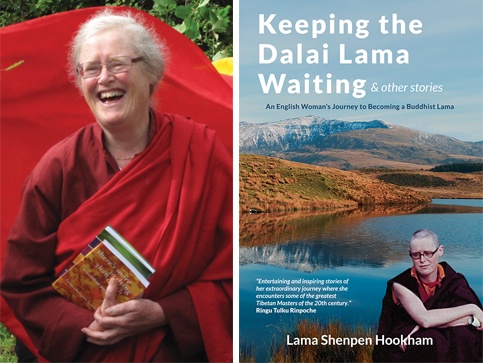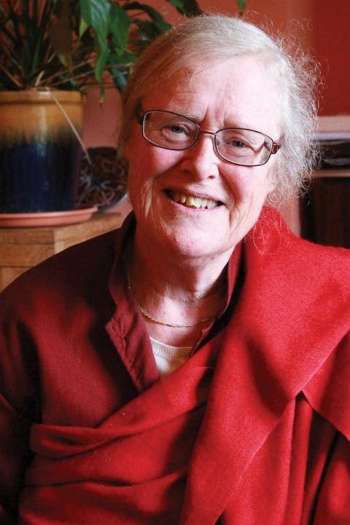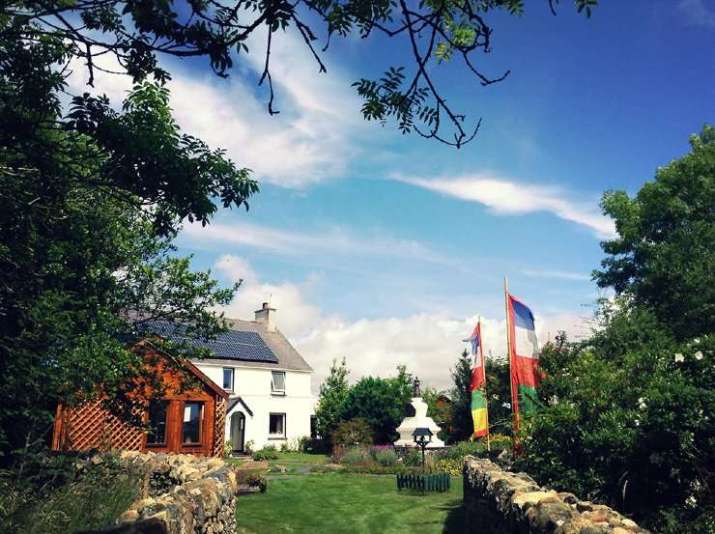Tucked away in the countryside of North Wales in the United Kingdom lies the Hermitage of the Awakened Heart, a Tibetan Buddhist retreat center led by Lama Shenpen Hookham, who has been practicing Buddhism for more than 50 years. Born in Essex, England, in 1946, Lama Shenpen Hookham's unlikely journey includes traveling to India at the age of 24, receiving instructions from multiple renown Tibetan lamas—such as Karma Thinley Rinpoche, Bokar Rinpoche, Kalu Rinpoche, and Khenpo Tsultrim Gyamtso Rinpoche—and traveling around Europe doing translation work for Gendun Rinpoche. Having been ordained as a nun in India by His Holiness the 16th Karmapa, Lama Shenpen Hookham was subsequently instructed to return to the West to spread the Dharma. Her book Keeping the Dalai Lama Waiting & Other Stories: An English Woman’s Journey to Becoming a Buddhist Lama (Shrimala Publishing 2020) offers a wonderful and personal account of her life story.
When I asked her about her writing process, which is described in detail at the beginning of the book, Lama Shenpen Hookham shared:
I used to write vignettes of moments in my life that struck me as somehow speaking for themselves—as stories in themselves—maybe just a page or two in length. They are the kind of thing I might repeat as an anecdote from time to time in just a few well-chosen sentences. As time went on, I started to realise they were not just amusing anecdotes—they contained real wisdom in them that I was in danger of missing by just telling the stories as somehow simply amusing. I started reading them to my students—mostly they were about encounters with my teachers and so my students loved to hear them—it helped them relate to the lineage in a very alive way.
This notion that her stories make the lineage come alive certainly rings true to me. I really appreciated Lama Shenpen Hookham’s unique insights into Tibetan Buddhism and the ways in which it has evolved over the last half a century. I was especially grateful that the book includes a glossary of people, allowing me to keep up with all the fascinating individuals she has encountered. And fascinating they are! Lama Shenpen Hookham does not hold back when it comes to describing the quirks of the different lamas, from Bokar Rinpoche’s attempts at paying back his “rather shady debt” to Lama Gelog’s “revolting” habit of hanging dried strips of meat inside his sleeping quarters. (75, 101) She also highlights some of the creative skillful means that the lamas employed to help people on their journey toward enlightenment, such as when Khenpo Rinpoche spent an entire summer helping her to gain flexibility of mind by going back and forth between telling her that she should continue living as a nun and then telling her that she should disrobe.

Lama Shenpen Hookham and the cover of Keeping the Dalai Lama
Waiting & Other Stories. Image courtesy of Lama Shenpen Hookham
Lama Shenpen Hookham notes she never really thought about the project of her book as being about her life. But when she collected the stories together, her students wanted them linked together as a narrative. So she hired someone to do that for and with her. “It has taken decades to come together in its present form,” she explains.
As her stories delineate, from a young age Lama Shenpen Hookham was endowed with a headstrong personality and an unbridled sense of spiritual devotion, which was initially expressed through Christianity. These attributes, while sometimes a nuisance—for example she recalls trying to convert her atheist father while he was sitting on the toilet—were no doubt key to her success when embarking in the decades of adventures and challenges that made her the lama she is today.
 Image courtesy of Lama Shenpen Hookham
Image courtesy of Lama Shenpen HookhamFunnily enough, “the loo” makes multiple apparitions in Keeping the Dalai Lama Waiting & Other Stories. I love this, because it offers a great insight into some of the challenges that Lama Shenpen Hookham faced throughout her journey, such as using a bucket as a squat-toilet when she first arrived in the suburbs of Delhi, going to relieve herself in the wilderness of Tilokpur armed with nothing but a small brass pot of water, and getting to the point where she was “unconsciously peeing out in the open alongside everyone else.” (159) Having been sent from one destination to another by her many teachers, Lama Shenpen Hookham spent much of her youth not knowing where she would be sleeping on a given night, how she would afford to eat or where she would go to the toilet. When I told Lama Shenpen Hookham that I was delighted about her multiple references to “the loo,” this came as a surprise to her:
I never noticed that! Now that I think about it I probably mention it more than I mention what anyone ate or wore! Maybe I mention it so often because of the amusing contexts in which so many stories occur, such as being stung on my bum by a hornet and finding myself caught short at a bus stop as almost the first thing that happens to me when I arrive back in England after an absence of five years!
Lama Shenpen Hookham’s stories are certainly amusing, but they are also very insightful. She exposes the many challenges she faced when trying to grasp teachings that were born from a completely different culture to the one in which she was raised, and she is very open about her own shortcomings during the process. Perhaps what is most gratifying is the fact that she invites the reader to explore intricate Buddhist teachings alongside her. For example:
Then one day out of the blue [Kalu Rinpoche] asked us whether, when we were sitting listening to his chanting and our mind wandered off home to the West, our mind was now in the West or the West was now here? This question grabbed me immediately. I considered it from time to time throughout the day as I listened to him chanting. Does the mind go anywhere? Does anything come from somewhere else into the mind? Does the mind stay in one place? If it does, where is that? If the mind is always in one place, how does it seem to go to other places? (30)
Because Lama Shenpen Hookham has interacted with and learned from so many renowned Tibetan teachers—many of whom have since died—and due to the central role she played when it comes to translating Tibetan concepts into English, it is undeniable that she has made a significant contribution to the way we understand Tibetan Buddhism in the West. Now that she spends most of her time in semi-retreat at The Awakened Heart, I asked her if she misses the excitement of her former life as a pilgrim:
I didn’t choose it particularly and I don’t miss it particularly. What is important to me is that I am living in a way that is conducive to serving and realizing the Dharma.
Lama Shenpen Hookham’s next book, The Guru Principle: A Guide to the Teacher-Student Relationship in Buddhism will be released on 17 August by Shambala Publications.
Reference
Hookham, Lama Shenpen. 2020. Keeping the Dalai Lama Waiting & Other Stories: An English Woman’s Journey to Becoming a Buddhist Lama. Criccieth, Gwynedd, UK: Shrimala Publishing.
See more
Awakened Heart Sangha
Buddha Within: The Teachings of Lama Shenpen Hookham
Related features from Buddhistdoor Global
Excerpts from The Zen Priestess and the Snake: A Woman’s Path of Transformation and Healing Through Rediscovery of the Great Mother Tradition
Ngakma Mé-tsal Wangmo – A Vicar of Vajrayana
Interview with Montse Castellà Olivé, President of Sakyadhita Spain
Sarah Beasley (Sera Kunzang Lhamo) on Discovering the Treasures of Lineage
Pioneering Himalayan Buddhism in the US: The Jacques Marchais Museum of Tibetan Art

















